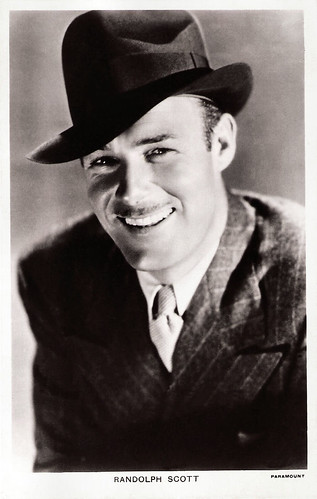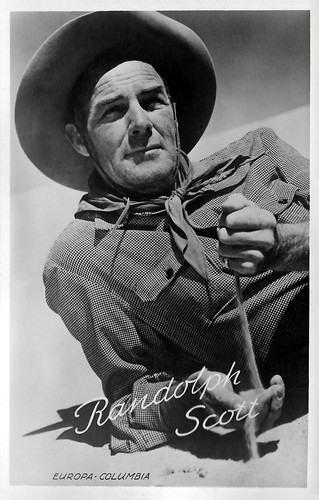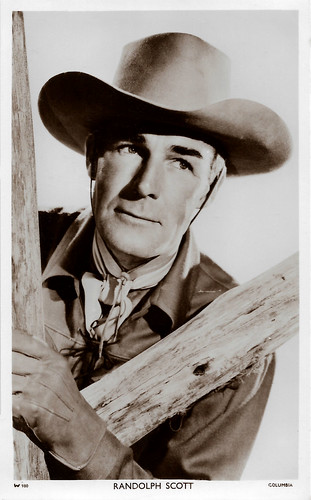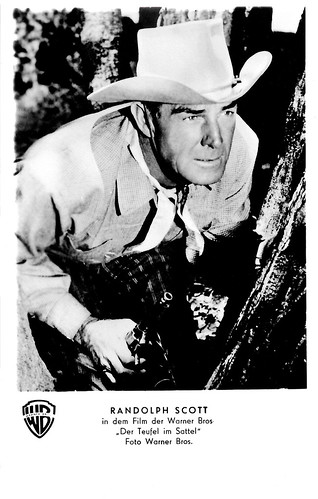
British postcard in the Picturegoer Series, London, no. 799. Photo: Paramount.

Dutch postcard. Photo: Europa - Columbia.

British postcard in the Picturegoer Series, London, no. W 980. Photo: Columbia.
Gaining much-needed acting experience
George Randolph Scott was born in 1898 as the second of six children of George and Lucy Crane Scott during a visit to Virginia. He was raised in Charlotte, North Carolina in a wealthy family. Because of his family's financial status, 'Randy' was able to attend private schools such as Woodberry Forest School. From an early age, Scott developed and displayed his athleticism, excelling in football, baseball, horse racing, and swimming.
After service with the U.S. Army in France in World War I, he attended the Georgia Institute of Technology but, after being injured playing football, he transferred to the University of North Carolina, from which he graduated with a degree in textile engineering and manufacturing.
Around 1927, he discovered acting and went to California, where he met Howard Hughes, who arranged a small part in a George O'Brien film called Sharp Shooters (John G. Blystone, 1928). Hughes also obtained an audition for him for Cecil B. DeMille's Dynamite (1929), a role that went instead to Joel McCrea. He was hired to coach Gary Cooper in a Virginia dialect for The Virginian (Victor Fleming, 1929) and played a bit part in the film.
On the advice of Cecil B. DeMille, Scott gained much-needed acting experience by performing in stage plays with the Pasadena Playhouse. In 1931 Scott played his first leading role opposite Sally Blane in Women Men Marry (Charles Hutchison, 1931), a film, now apparently lost, made by a Poverty Row studio called Headline Pictures. In 1932 Scott appeared in a play at the Vine Street Theatre in Hollywood, 'Under a Virginia Moon'. Paramount scouts saw him and offered him a contract. Paramount cast him as the lead in Heritage of the Desert (Henry Hathaway, 1932), his first significant starring role and also the one that established him as a Western hero. Henry Hathaway made his directorial debut with Heritage of the Desert. The film was popular and Scott would go on to make ten 'B' Westerns loosely based on the novels of Zane Grey.
Scott met Cary Grant, another Paramount contract player, on the set of Hot Saturday (William A. Seiter, 1932) and the pair soon moved in together. Till 1944, they lived in a beach house known jocularly as Bachelor Hall. The close friendship between Scott and Grant and the steady stream of women into and out of Bachelor Hall fed rumour mills for years. Many believed that Grant and Scott were lovers, and the women were arranged by the film studios for public effect. This cohabitation ended in 1942 when Cary Grant married the Woolworth heiress Barbara Hutton, then the richest woman in the world. Scott remained close friends with Grant until the day he died. When he heard of his old friend's death, he reportedly put his head in his hands and wept. He himself would die a little over 2 months afterwards.

American postcard. Randolph Scott in The Last of the Mohicans (George B. Seitz, 1936).

British postcard by Publicity Photographs LTD, London, no. 434. Photo: Paramount.

British postcard in the Colourgraph Series, London, no. C 256. Photo: Paramount.
Altering into a stoic, craggy, and uncompromising figure
Paramount loaned Randolph Scott to RKO Radio Pictures to support Fred Astaire, Ginger Rogers and Irene Dunne in Roberta (William A. Seiter, 1935), a hugely popular adaptation of the Broadway musical. He was loaned to independent producer Edward Small, to play Hawkeye in the adventure classic, The Last of the Mohicans (George B. Seitz, 1936), adapted from the 1826 novel by James Fenimore Cooper. A big hit, the film gave Scott his first unqualified 'A' picture success as a lead. He was a love interest for Mae West in Go West, Young Man (Henry Hathaway, 1936) and was reunited with Irene Dunne in a musical, High, Wide and Handsome (Rouben Mamoulian, 1937).
Randolph Scott married and divorced wealthy heiress Marion DuPont in the late 1930s. In the 1940s he appeared in several war films, notably To the Shores of Tripoli (H. Bruce Humberstone, 1942), Bombardier (Richard Wallace, 1943), the Canadian warship drama Corvette K-225 (Richard Rosson, 1943), Gung Ho! (Ray Enright, 1943) and China Sky (Ray Enright, 1945). Scott was a pleasant figure in comedies, dramas, and the occasional adventure, but it was not until he began focusing on Westerns in the late 1940s that he reached his greatest stardom. In 1946, after playing roles that had him wandering in and out of the saddle for many years, Scott appeared in Abilene Town (Edwin L. Marin, 1946), which cast him in what would become one of his classic images, the fearless lawman cleaning up a lawless town. The film cemented Scott's position as a cowboy hero; from this point on, all but two of his starring films would be Westerns.
He became one of the top box office stars of the 1950s and, in the Westerns of Budd Boetticher especially, a critically important figure in the Western as an art form. The seven films he shot under Boetticher's direction are classic Westerns: Seven Men from Now (1956), The Tall T (1956), Decision at Sundown (1957), Buchanan Rides Alone (1958), Westbound (1958), Ride Lonesome (1959) and Comanche Station (1960). His screen persona altered into that of a stoic, craggy, uncompromising figure, a tough, hard-bitten man seemingly unconnected to the light comedy lead he had been in the 1930s. In these films, the natural entourage is the rugged landscapes of the Californian Sierras.
Following a critically acclaimed, less-heroic-than-usual role in one of the classics of the genre, Ride the High Country (Sam Peckinpah, 1962) opposite Joel McCrea, Scott retired from films at the age of 64. A multimillionaire as a result of smart investments, Scott spent his remaining years playing golf and avoiding film industry affairs, stating that he didn't like publicity.
In 1987, he died in Beverly Hills of a heart and lung disease at the age of 89. He was survived by his second wife, Patricia Stillman, and their two adopted children, Christopher and Sandra. He was interred at Elmwood Cemetery, Charlotte, North Carolina, USA, just four blocks from his boyhood home at 312 W. 10th Street.

French postcard by Editions P.I., presented by Les Carbones Korès, Paris, no. 480. Photo: Warner Bros, 1953.Randolph Scott in Colt .45 (Edwin L. Marin, 1950).

German postcard by Netter's Star Verlag, Berlin, no. 1475. Photo: Warner Bros. Randolph Scott in Tall Man Riding (Lesley Selander, 1955).

West-German postcard by Kunst und Bild, Berlin, no. A 123. Photo: Columbia.

Belgian collectors card by Merbotex, Bruxelles, for cinéma Kursaal in Bertrix, no. 60. Photo: Warner Bros.
Sources: Jim Beaver (IMDb), Wikipedia and IMDb.
No comments:
Post a Comment